they/them (any) | biromantic asexual | early 20s
Last active 60 minutes ago
Don't wanna be here? Send us removal request.
Note
your (extremely powerful) j&w art is truly saying the quiet part loud of the original text tho. i was rereading some of the stories this past week and bertie's inner monologue is just like: "i decided to resist the bit (horse&rider metaphor??), to prove that i wasn't Jeeves' dashed serf (now who's getting into the feudal spirit???), then caved in 5 minutes later, like a man reconciling with his wife after a quarrel, and when i conceded jeeves' point he gazed at me like i was a wayward child returning home at last. but no. i'm not one of those men who's a slave to his valet. why do you ask?" (literally all paraphrased quotes from Wodehouse. whatever these 2 have going on it's dynamite)
OH MY GOD THANK YOU?? YES EXACTLY!!! The way Bertie performs mental gymnastics to convince himself he's totally independent while literally folding like a house of cards the moment Jeeves so much as raises an eyebrow??? The metaphors. The sheer emotional weight of Jeeves' 'fond but exasperated' looks. The ‘I’m not his serf’ speech immediately followed by ‘well anyway I did what he said’…He wrote this and thought we wouldn’t NOTICE??? Sir. Please.
22 notes
·
View notes
Text
That “he was like a calculating machine” remark was specifically in the context of Holmes not experiencing love or attraction towards women. Holmes’ coldness is always brought up as an explanation for his lack of interest in women.
Holmes himself draws on the idea. It’s so sad, isn’t it? The way we are punished and taught to punish ourselves for not loving as we are told we’re supposed to.
327 notes
·
View notes
Text

The Adventure of the Final Problem illustration by Arthur Twidle (1903)
67 notes
·
View notes
Text
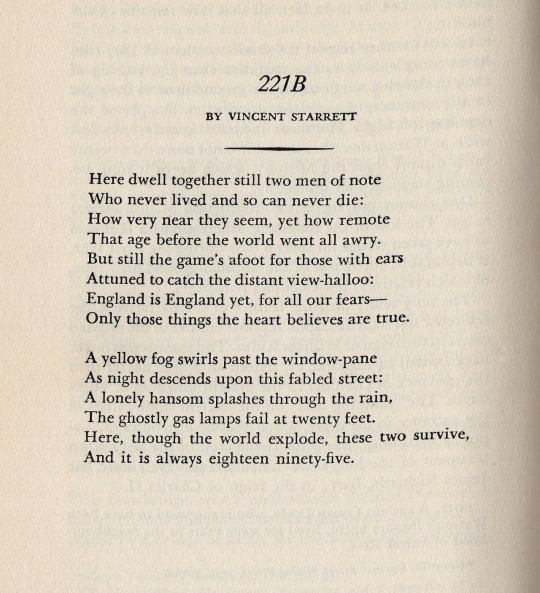
Just learned about the existence of this poem written by Vincent Starrett in 1942. I'm always so happy when I can learn more about the Sherlockian fandom and discover more of Sherlockiana.
5K notes
·
View notes
Text
The Private Life of Sherlock Holmes dir: Billy Wilder, 1970
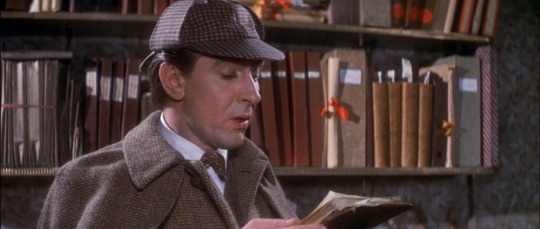
I only watched The Private Life of Sherlock Holmes for the first time a few days ago but it lights my brain up in that special way that I know I’ll revisit it a lot. Don’t get me wrong, it’s far from perfect, for one thing Colin Blakely’s Watson is a little too shouty for me, but it’s very worthwhile to check out despite its shortcomings, which I think mostly come from the fact that so much was cut from the intended script.
I absolutely love Robert Stephens as Holmes. His face is so good, he has a way of looking at Watson when he doesn’t know he’s being observed that is very soft. I thought I was hallucinating the beginning of this movie with Holmes telling the ballet dancer he’s gay and in a relationship with Watson. I thought it was going to be played for a joke, and it was a bit, but it didn’t just end there. Holmes and Watson have a conversation about the repercussions in a lengthy scene that turns very serious by the end. I can’t believe this was 1970 and no one has since tried to build on this specific dynamic in a more meaningful way. Someone needs to remake this into a mini-series exactly how Billy Wilder intended it to be, here’s hoping public domain can make it so.
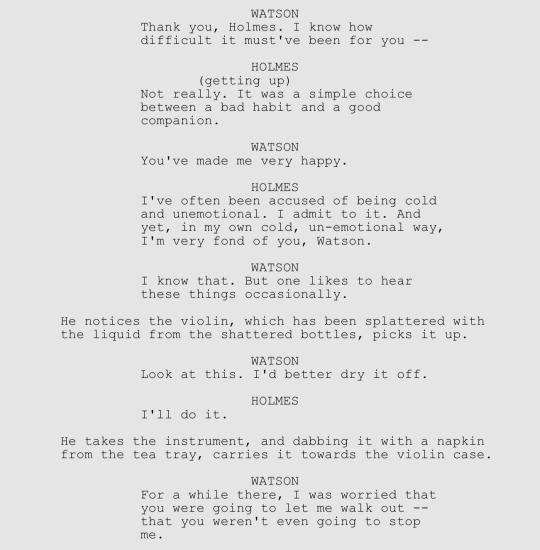
[above: script page from the cut story The Curious Case of the Upside Down Room, where Watson creates a fake case to make Holmes feel better]
Also, the backstory of the making of this film is so out of control: Robert Stephens’s nervous breakdown and suicide attempt during the production, the amount of years Billy Wilder was trying to write it and get it made, the interference of ACD’s son, the Loch Ness monster prop that the crew lost in actual Loch Ness, the immense scope of the episodic story they were going for, the way it got cut down from its original 3 hour 45 minute runtime and how that cut footage was lost forever! (this is crazy! everyone go check your attics and storage lockers right now).
In one of the interviews I found, Robert Stephens says “if something is boring — if it’s three minutes long it’s too long, but if it’s interesting it’s never long enough…you don’t want it to end.” Big same Toby Stephens’ dad, big SAME. I didn’t want it to end. I read the uncut script and I am just floored at what we missed out on. Thankfully some footage and audio remain of some of the cut scenes (but still! check your basements too).
Just fully let it settle into your brain that they filmed all of these stories in the script, and then cut most of it away. Like that is mind-blowing to me, it existed at one point as it was fully intended to be. If this was made now during home entertainment times, they would have no problem releasing an almost four-hour movie, but at the very least there would be a big director’s cut dvd release and we would be enjoying all the small Holmes x Watson moments we deserve.
Anyway, in pretty short order I found a bunch of interesting links to stuff, details below. I also consulted my very well-thumbed Conversations with Wilder book by Cameron Crowe, but there wasn’t that much more information in there. I have Robert Stephens’ memoir Knight Errant and the TPLOSH blu-ray on order so I’ll add to this post if I find any more good resources. Let me know if I’m missing anything, and enjoy!
Full movie on YouTube (x) <-update: this link went private, but it's also streaming for free on Tubi and Freevee, and available to rent on YouTube, Google Play, and Apple TV
Original roadshow draft of script on Internet Archive (x)
Missing footage: Prologue [sound only plus stills] (x), The Curious Case of the Upside Down Room [sound only plus stills] (x), The Dreadful Business of the Naked Honeymooners [footage and soundtrack only, no sound dialogue] (x), alternate ending [sound only] (x)
Making of documentary that includes behind-the-scenes snippets of some of the cut scenes [this doc is in German, but you can turn on the auto-translate to English in the YouTube settings] (x)
Interview with Ernst Walter, film editor of TPLOSH (x)
Interview with Christopher Lee “Mr. Holmes, Mr. Wilder” 2003 (x)
My YouTube playlist with all of the above links in one place plus an excellent fan vid by Just Bee that I added to the list because it’s just so good (x)
Missing Movies: A Case for Sherlock Holmes from 1994 BBC Radio 2 on Soundcloud [includes interview with Robert Stephens and folks involved in the production] (x)
Articles about the lost Loch Ness monster prop (x) (x)
The soundtrack by Miklós Rózsa (x)
158 notes
·
View notes
Text
SHERLOCK & CO PILOT IS OFFICIALLY FULLY ANIMATED FOR YOUR VIEWING PLEASURE
Are you a Sherlock & Co fan?
Did you know that over 50+ artists came together and animated the first episode of the podcast and you can watch it on YouTube?
No?! Then click here to watch it now!
https://youtu.be/T-w68ryhsf0?si=tTC1a4Y6LVWk_aG-
Sherlock and Co Pilot MAP
-Hosted and edited by Kris / @goofywhovian
-Co-Hosted by Deer / @deerlybeloveddd
-Huge thanks to Joel emery, Jones and the rest of the Sherlock and Co team!
-Thumbnail art by Lev https://x.com/weirdgir...
ANIMATORS IN ORDER OF APPEARANCE-
Intro 1 - Kris / @goofywhovian
1- Killermaxaroo / killermaxaroo
2- Tea https://x.com/teapartye
3- bluecarbun / schuhloch
4- AnnoyingCat / annoyingcat413
5- Alex / starlightscribbles_16
6- Sephlock / falling-raine
7- Enderman / penderbend
Intro 2- Arthur / algae_illustrations
8- Kris / @goofywhovian
9- Dai - DungeonsandDinosaurs on discord
10- Pat https://x.com/abstract...
11- Dev / achillesistiredofhisfe...
12- Crashdown / crashdown
13- KingCharl / cinnamontoasterr
14- Sealbug https://x.com/sealbug
15- Marie / marie_artsy1
16- Henry https://x.com/janthony...
17- Otto / funnihumanbeing
18- Dai - DungeonsandDinosaurs on discord
19- Kris / @goofywhovian
20- bluecarbun / schuhloch
21- Yurisupernova / yurisupernova
22- Wazz / projectorthus
23- Cheez / @fcheez
24- Moon / moonboonlafayette
25- Sisterkristerrr https://x.com/sisterkr...
26- Static / ._static_
27- Pepper https://x.com/Pepperpe...
28- Dai - DungeonsandDinosaurs on discord
29- Rat / ratmakingart
30- Arthur / algae_illustrations
31- multiashking / multiashking
32- Rat / ratmakingart
33- Toaster / resetoaster
34- Enderman / penderbend
35- Pepper https://x.com/Pepperpe...
36- Coat https://x.com/iwanttha...
37- Eve / evedrawzz
38- grape / xgraavyx
39- el / el-on-mars
40- Emmaculate / em_maculate
41- egg / biblical-egg
42- Garfieldpinkeye / garfieldspinkeye
43- egg / biblical-egg
44- Box / box.isnotconfused
45- Wazz / projectorthus
46- Jones https://x.com/4thelney...
47- Ramt https://x.com/ramteronk
48- Marie / marie_artsy1
49- egg in hell / egg____________________6
50- Killermaxaroo / killermaxaroo
51- bluecarbun / schuhloch
52- Sisterkristerrr https://x.com/sisterkr...
53- Bub / reibub
54- starr / chaos-and-sparkles
55- AnnoyingCat / annoyingcat413
56- Neko https://x.com/Nekoholmes3
57- James / jahames102
58- Prox / the_proxys
59- Tsuki https://x.com/tsukihas...
60- Moon / moonboonlafayette
61- DB https://x.com/doodlebl...
62- Box / box.isnotconfused
63- Jamie / @brother_m1ne
64- Sisterkristerrr https://x.com/sisterkr...
65- duckmorganduck / duckmorganduck
66- Deer / @deerlybeloveddd
67- B0tler https://x.com/b0tler
68- Bird / birdiful_human
69- starr / chaos-and-sparkles
70- Garfieldpinkeye / garfieldspinkeye
71- Henry https://x.com/janthony...
72- Ramt https://x.com/ramteronk
73- Killermaxaroo / killermaxaroo
74- annoyingcat / annoyingcat413
75- Crashdown / crashdown
76- eardefenders / eardefenders
76.5 (numbers are a bit messed up)- Bub / reibub
77- Tea https://x.com/teapartye
78- My https://linktr.ee/maya...
79- Pat https://x.com/abstract...
80- Emmaculate / em_maculate
81- Harvey https://x.com/frosnpls
82- Static / ._static_
83- Nat https://linktr.ee/NatO...
Outro- Kris / @goofywhovian
291 notes
·
View notes
Text

elmer’s glue lied…you can still fucking see it. but whatever! finally glad to have this finished! a tie that binds ❤️
157 notes
·
View notes
Text
I was browsing through the index of the original Sherlock Holmes story, as one does, when a thought struck me. While Holmes' personal life was utterly devoid of women, his professional one was positively overflowing with them.
I think something like half the stories have a woman. Additionally I'd estimate a solid 3/4 of the stories have a woman or several women, appear in a pivotal role, whether as victim, villain, or heroes.
And quite aside from the sheer number of women in Doyle's stories, there's also the range of them. We're presented with almost every type of woman imaginable. We have clever and competent women, craven women, women driven by ambition and devoid of empathy and compassion. We have warm women, cold women, women caught in circumstances beyond their control and those who take charge of those circumstances.
While I think it would be a reach to call Doyle's writing feminist, the fact remains that in the original Sherlock Holmes stories women are allowed a full range of humanity. Which quite frankly make the fact that adaptions too often fail abysmally on this account, though I think some interesting conclusions can be drawn between an adaptions insistence upon thrusting women into Holmes' personal life while simultaneously removing them from the prominence they held in his professional work.
196 notes
·
View notes
Text

The Game is Afoot!
Back to reading some Sherlock Holmes stories 📖🔎
425 notes
·
View notes
Text
The Time Sir Arthur Conan Doyle Had A Pet Sea Snail
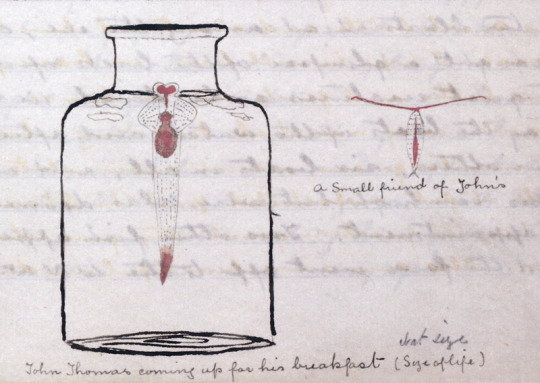
I've been reading the diary Doyle kept of his time as a ship's surgeon aboard an Arctic whaling vessel in 1880, and you all deserve to hear the tale of John Thomas, Doyle's pet Clione limacina, which he drew in the above picture.
Doyle, then 21, found John Thomas on June 3rd, 1880:
Brought up a most beautiful Clio or Sea Snail, a couple of inches long, looking like some weird little fairy. I have stuck him in a pickle bottle and christened him "John Thomas." I hope he will live, we have put some butter and pork into his house.
The following day, Doyle attempted to feed John Thomas and wrote a short poem about the snail:
John Thomas is in an awful passion. We left the pickle bottle far from the fire, and as there are 11 degrees of frost it froze up and John has caught cold. He is sitting in a corner with his tail in his mouth, just as a sulky baby sticks its thumb into its potato box. I have drawn John's attention to the butter & pork and he took a hurried breakfast, but seems to have business of importance down at the bottom of the bottle. He's thinking perhaps of Where his rude shell by the Gulf Stream lay, There were his little Sea Snails all at play, There their Amoeboid mother, he their sire Butchered to make a whale's holiday.
On June 5th, Doyle reported that "John is well and hearty," and on the 6th, he wrote:
John was up before me and took a heavy breakfast. He is now gyrating round the top of his bottle surveying his new kingdom apparently and meditating a map. I put him in a bucket every evening where he wanders fancy free for an hour or two.
Unfortunately, on the 10th, Doyle reported that John Thomas had departed the mortal plane.
John Thomas died on the 8th of June, regretted by a large circle of acquaintances
He wrote a touching eulogy for his tiny friend:
He was a right thinking and high minded Clio, distinguished among his brother sea snails for his mental activity as well as for physical perfection. He never looked down upon his smaller associates because they were protozoa while he could fairly lay claim to belong to the high family of the Echinodermata or Annulosa. He never taunted them with their want of a water vascular system, nor did he parade his own double chain of ganglia. He was a modest and unassuming blob of protoplasm, and could get through more fat pork in a day than many an animal of far higher pretensions. His parents were both swallowed by a whale in his infancy, so that what education he had was due entirely to his own industry and observation. He has gone the way of all flesh so peace be to his molecules.
John Thomas' descendants still live in the Arctic Ocean today, and they look pretty cool!
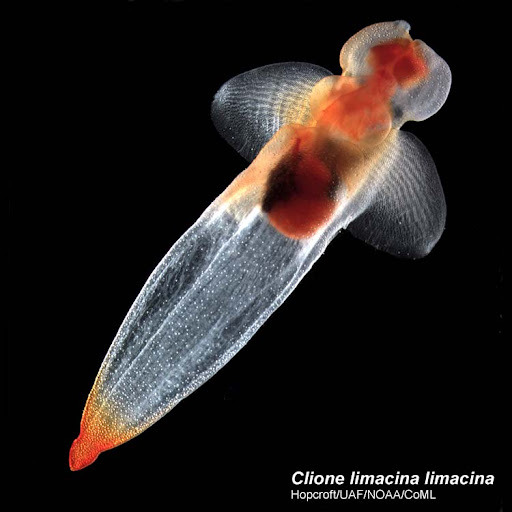
115 notes
·
View notes
Text

And they say this man was neurotypical
360 notes
·
View notes
Text





















shout out to The Arthur Conan Doyle Encyclopedia for the pics!
274 notes
·
View notes
Text
Surviver of the falls
The relentless fury of the Reichenbach Falls surged around Dr. John Watson as he hurriedly descended the treacherous path to the base. His heart pounded in sync with the thunderous roar of the water, each step driven by the hope that he was not too late. As he reached the bottom, the sight before him was both chilling and surreal: the lifeless form of Professor Moriarty, his face contorted in a final grimace, floated downstream, carried away by the inexorable current.
Watson's gaze darted frantically over the water, searching for any sign of his dear friend, Sherlock Holmes. Amid the frothing turmoil, a figure emerged, clinging to life with unyielding tenacity. There, struggling against the relentless force of the falls, was Holmes—battered, bruised, and bleeding, yet unmistakably alive.
"Holmes!" Watson's cry was swallowed by the deafening cascade, but his legs propelled him forward, plunging into the icy stream. The freezing water stung his skin, but he paid it no heed. All that mattered was reaching Holmes.
The detective, his once immaculate visage now marred by the ravages of their encounter with Moriarty, was dragging himself to the shore, his breath labored and shallow. Broken ribs protested with every movement, and his body bore the marks of a fierce struggle. Yet, his eyes, sharp and keen, met Watson's with a mixture of relief and unspoken emotion.
"Watson," Holmes rasped, his voice barely audible over the roar. He stumbled, and Watson was there in an instant, steadying him. They stood knee-deep in the churning water, their clothes soaked and their bodies battered, yet their spirits unbroken.
Without a word, Watson enveloped Holmes in a fierce embrace, heedless of the detective's injuries or the frigid embrace of the stream. Tears mingled with the rain and spray, their faces streaked with a potent blend of relief, sorrow, and an emotion that had always lain just beneath the surface.
In that moment, as they clung to each other, their bond was laid bare. It was more than friendship, more than the camaraderie forged in the fires of countless adventures. It was a connection that transcended words, a profound understanding that they had found something rare and irreplaceable in each other.
"Holmes," Watson whispered, his voice thick with emotion. "I thought I'd lost you."
"You know I'm far too stubborn to die, my dear"
They stood there, embraced above the roar of the Reichenbach Falls, the world around them fading into insignificance. Their eyes spoke volumes, conveying what words could not...

32 notes
·
View notes
Text
never forget that one time Sherlock Holmes (while Watson was trying to go to bed) took all the cushions and pillows from the room, put them on the floor, sat on them in his dressing gown, and stayed up all night smoking his pipe. the next morning he woke poor Watson up at 4am, called himself one of the biggest fools in Europe and said he deserved to be 'kicked from here to Charing Cross', then said that he'd solved the mystery and the answer was in the bathroom. he had solved the mystery.
120 notes
·
View notes
Text
I also have the entire Sherlock Holmes canon as a single word file which is very nice if you're just looking for specific words or such
(like 'my dear Watson' is famously said 94 times over all stories, 'my dear holmes' is said 15 times etc. etc.)
btw people,
in the depths of my Sherlock Holmes obsession, I downloaded all The Strand Magazine pieces that contained a Sherlock Holmes story and added them up as the collections that they would later be released in (with the magazine cover and table of contents and correct page numbers and everything)
so if anyone would want that, here:
1K notes
·
View notes
Text
btw people,
in the depths of my Sherlock Holmes obsession, I downloaded all The Strand Magazine pieces that contained a Sherlock Holmes story and added them up as the collections that they would later be released in (with the magazine cover and table of contents and correct page numbers and everything)
so if anyone would want that, here:
#if this is somewhat illegal or bad to upload or anything please tell me#but since they are free of copyright now and accessible on The Internet Archieve anyway i hope this is fine?#looking back the custom table of contents looks so clean#the font for it is called Baskerville btw which is so fun#sherlock holmes#acd canon#acd holmes
1K notes
·
View notes
